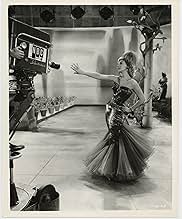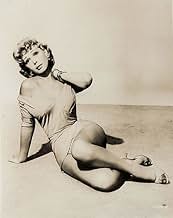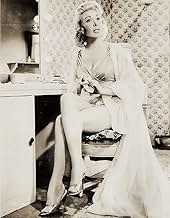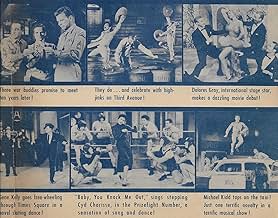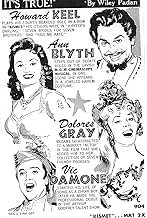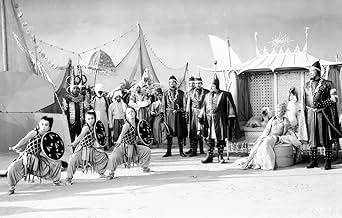Dolores Gray(1924-2002)
- Actress
- Soundtrack
Dabbling in practically every facet of show business during her over six-decade career -- nightclubs, cabaret, radio, recordings, TV, film and Broadway -- sultry, opulent, larger-than-life singing star Dolores Gray, distinctive for her sharp, somewhat equine features, lived the high life for most of her time on earth.
She was born Sylvia Dolores Finkelstein in Los Angeles, California on June 7, 1923, the daughter of vaudevillian parents (her father Harry went by the stage name of "Harry Vernon") who divorced when she was quite young. An older brother, Richard Vernon (later Gray) would also go into the entertainment business. Dolores attended Polytechnic High School in the Sun Valley suburb of Los Angeles and, while there, became a member of the girl's glee club.
Singing in Hollywood supper clubs as early as age 14, Dolores was discovered as a teenager by Rudy Vallee, who helped make her a minor celebrity on his self-titled radio show. She went on to earn two brief, uncredited bits as a singer in the films Lady for a Night (1942) (singing "Has Anybody Seen My Man?") and Mr. Skeffington (1944) (singing "It Had to Be You"). Making her Broadway debut in the show "Seven Lively Arts," a Broadway revue produced by Billy Rose, she co-starred in the musical "Are You With It?" with Johnny Downs a year later.
During this time Dolores developed a strong reputation on both coasts as a cabaret and supper club entertainer. By 1945, she was starring in her own radio program. A chance of a lifetime occurred in 1947 when Dolores gussied up London's post-war theater district as marksman "Annie Oakley" in the Broadway musical hit "Annie Get Your Gun." She was afforded this huge opportunity after the Broadway star, Ethel Merman, turned down the tour. Dolores became the toast of the West End for over two years.
Broadway beckoned following her London success and the dusky alto returned to New York. Co-starring with Bert Lahr in the Broadway musical revue "Two on the Aisle" (1951), which had a decent run, she went on to earn raves in the very short-lived 1953 musical "Carnival in Flanders" with John Raitt. She won the Tony award for this in spite of the fact it closed after only six performances! Dolores would return to Broadway in the 1959 musical "Destry Rides Again" co-starring pre-TV star Andy Griffith and earning a Tony nomination. This was followed by the ill-fated 1967 musical "Sherry!" based on the Kaufman/Hart play "The Man Who Came to Dinner."
Not only was Broadway interested when Dolores returned from London, but MGM also wanted in on the action. Signing the leggy star to a short-term contract, the results were disappointing as the "Golden Age of Hollywood" musicals was on a major decline. She did manage, however, to nab a few scene-grabbing second leads in such musicals as It's Always Fair Weather (1955) starring Gene Kelly; Kismet (1955) with Howard Keel and Ann Blyth; The Opposite Sex (1956) starring June Allyson; and in Joan Collins, a rather misguided musical version of "The Women" film classic. She would also co-star in the chic non-musical Designing Woman (1957) starring Gregory Peck and Lauren Bacall. And then it was over for Dolores in movies.
As the years went by, Dolores would attract tabloid attention with her extravagant lifestyle, outlandish clothes and "Auntie Mame"-like joie de vivre. Being the trooper she was, she found work on TV variety (she made several appearances on "The Ed Sullivan Show"), recorded for Capitol Records (the album "Warm Brandy"), and remained a top-of-the-line nitery star for decades to come. In 1973, she returned to London and replaced Angela Lansbury in the musical "Gypsy" at the Piccadilly Theatre. Over a decade later (1986), she came in as a replacement Dorothy Brock in the Broadway revival of "42nd Street," and, a year later, was featured in the London production of Sondheim's "Follies," earning show-stopping applause for her version of the classic song "I'm Still Here."
Despite her somewhat outré reputation, Dolores married only once -- to California businessman and race horse owner Andrew Crevolin in 1967. Although the marriage lasted only 9 years, the couple never divorced -- in fact, they never even formally separated as she was a devout Catholic. She and Crevolin would remain close friends until his death in 1992. Dolores herself passed away a decade later in her Manhattan apartment of a heart attack at age 78 on June 26, 2002.
She was born Sylvia Dolores Finkelstein in Los Angeles, California on June 7, 1923, the daughter of vaudevillian parents (her father Harry went by the stage name of "Harry Vernon") who divorced when she was quite young. An older brother, Richard Vernon (later Gray) would also go into the entertainment business. Dolores attended Polytechnic High School in the Sun Valley suburb of Los Angeles and, while there, became a member of the girl's glee club.
Singing in Hollywood supper clubs as early as age 14, Dolores was discovered as a teenager by Rudy Vallee, who helped make her a minor celebrity on his self-titled radio show. She went on to earn two brief, uncredited bits as a singer in the films Lady for a Night (1942) (singing "Has Anybody Seen My Man?") and Mr. Skeffington (1944) (singing "It Had to Be You"). Making her Broadway debut in the show "Seven Lively Arts," a Broadway revue produced by Billy Rose, she co-starred in the musical "Are You With It?" with Johnny Downs a year later.
During this time Dolores developed a strong reputation on both coasts as a cabaret and supper club entertainer. By 1945, she was starring in her own radio program. A chance of a lifetime occurred in 1947 when Dolores gussied up London's post-war theater district as marksman "Annie Oakley" in the Broadway musical hit "Annie Get Your Gun." She was afforded this huge opportunity after the Broadway star, Ethel Merman, turned down the tour. Dolores became the toast of the West End for over two years.
Broadway beckoned following her London success and the dusky alto returned to New York. Co-starring with Bert Lahr in the Broadway musical revue "Two on the Aisle" (1951), which had a decent run, she went on to earn raves in the very short-lived 1953 musical "Carnival in Flanders" with John Raitt. She won the Tony award for this in spite of the fact it closed after only six performances! Dolores would return to Broadway in the 1959 musical "Destry Rides Again" co-starring pre-TV star Andy Griffith and earning a Tony nomination. This was followed by the ill-fated 1967 musical "Sherry!" based on the Kaufman/Hart play "The Man Who Came to Dinner."
Not only was Broadway interested when Dolores returned from London, but MGM also wanted in on the action. Signing the leggy star to a short-term contract, the results were disappointing as the "Golden Age of Hollywood" musicals was on a major decline. She did manage, however, to nab a few scene-grabbing second leads in such musicals as It's Always Fair Weather (1955) starring Gene Kelly; Kismet (1955) with Howard Keel and Ann Blyth; The Opposite Sex (1956) starring June Allyson; and in Joan Collins, a rather misguided musical version of "The Women" film classic. She would also co-star in the chic non-musical Designing Woman (1957) starring Gregory Peck and Lauren Bacall. And then it was over for Dolores in movies.
As the years went by, Dolores would attract tabloid attention with her extravagant lifestyle, outlandish clothes and "Auntie Mame"-like joie de vivre. Being the trooper she was, she found work on TV variety (she made several appearances on "The Ed Sullivan Show"), recorded for Capitol Records (the album "Warm Brandy"), and remained a top-of-the-line nitery star for decades to come. In 1973, she returned to London and replaced Angela Lansbury in the musical "Gypsy" at the Piccadilly Theatre. Over a decade later (1986), she came in as a replacement Dorothy Brock in the Broadway revival of "42nd Street," and, a year later, was featured in the London production of Sondheim's "Follies," earning show-stopping applause for her version of the classic song "I'm Still Here."
Despite her somewhat outré reputation, Dolores married only once -- to California businessman and race horse owner Andrew Crevolin in 1967. Although the marriage lasted only 9 years, the couple never divorced -- in fact, they never even formally separated as she was a devout Catholic. She and Crevolin would remain close friends until his death in 1992. Dolores herself passed away a decade later in her Manhattan apartment of a heart attack at age 78 on June 26, 2002.


